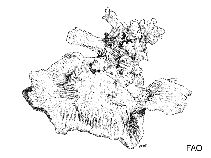Caulastraea furcata Dana, 1846
Torch coral
Upload your photos
Google image | No image available for this species;
drawing shows typical species in Merulinidae.
Google image | No image available for this species;
drawing shows typical species in Merulinidae.
Classification / Names Tên thường gặp | Các synonym ( Các tên trùng) | CoL | ITIS | WoRMS
Hexacorallia | Scleractinia | Merulinidae
Environment: milieu / climate zone / Mức độ sâu / distribution range Sinh thái học
Cùng sống ở rạn san hô; Mức độ sâu 0 - 40 m (Tài liệu tham khảo 848). Tropical; 30°N - 27°S, 39°E - 172°W (Tài liệu tham khảo 848)
Distribution Các nước | Các khu vực của FAO | Các hệ sinh thái | Những lần xuất hiện | Những chỉ dẫn
Indo-Pacific: From Somalia and Madagascar, east to the Samoas, north to Ryukyu, south to New Caledonia.
Length at first maturity / Bộ gần gũi / Weight / Age
Chín muồi sinh dục: Lm ? range ? - ? cm
Short description Hình thái học
Formation: phaceloid. Corallites: irregular, crowded if in restricted space; less than 19 mm across. Septa: exsert, irregular, varying thickness. Polyps: fleshy; thick septa give prominent radiating stripes to the upper corallite surface. Color: brown or green with green oral discs (Ref. 848).
Occurs in protected reef slopes with partly sandy substrate (Ref. 848). Also in lagoons (Ref. 98471). No bleaching observed in Palau (Ref. 66144).
Life cycle and mating behavior Chín muồi sinh dục | Sự tái sinh sản | Đẻ trứng | Eggs | Sự sinh sản | Larvae
Hermaphroditic (Ref. 113712). Mature gametes are shed into the coelenteron and spawned through the mouth. Life cycle: The zygote develops into a planktonic planula larva. Metamorphosis begins with early morphogenesis of tentacles, septa and pharynx before larval settlement on the aboral end (Ref. 833).
Main reference
Các tài liệu tham khảo | Người điều phối | Người cộng tác
Nemenzo, F. Sr. 1986. (Tài liệu tham khảo 910)
IUCN Red List Status
(Tài liệu tham khảo 130435: Version 2024-2)
Least Concern (LC) ; Date assessed: 24 October 2023
CITES status (Tài liệu tham khảo 108899)
Appendix II: International trade monitored
CMS (Tài liệu tham khảo 116361)
Not Evaluated
Threat to humans
Human uses
| FishSource |
Các công cụ
Thêm thông tin
Sinh thái dinh dưỡng
Các loại thức ăn
Thành phần thức ăn
Thành phần thức ăn
Food rations
Các động vật ăn mồi
Thành phần thức ăn
Thành phần thức ăn
Food rations
Các động vật ăn mồi
Sinh thái học
Population dynamics
Sự sinh trưởng
Max. ages / sizes
Length-weight rel.
Length-length rel.
Length-frequencies
Mass conversion
Bổ xung
Sự phong phú
Max. ages / sizes
Length-weight rel.
Length-length rel.
Length-frequencies
Mass conversion
Bổ xung
Sự phong phú
Life cycle
Distribution
Human Related
Aquaculture profiles
Stamps, coins, misc.
Stamps, coins, misc.
Outreach
Các tài liệu tham khảo
Các nguồn internet
BHL | BOLD Systems | CISTI | DiscoverLife | FAO(Publication : search) | Fishipedia | GenBank (genome, nucleotide) | GloBI | Gomexsi | Google Books | Google Scholar | Google | PubMed | Cây Đời sống | Wikipedia (Go, tìm) | Tạp chí Zoological Record
Estimates based on models
Preferred temperature
(Ref. 115969): 25 - 29, mean 28 (based on 804 cells).
Price category
(Tài liệu tham khảo 80766):
Unknown.



